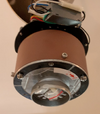ForumUser1
Member
Hi Fellows!
So, another failure of electronics/motor … I gave up on trying to repair this a couple of years ago.
I have a five year old six speed DC powered ceiling fan made by Minka Wire - 84”. It has, from the beginning been a real PITA.
Initially, I noted - the RPM speeds were off - Speed 1 was far too fast, and then Speeds 2-4 were about the same, and 5-6 about the same. So, I put a piece of tape on one of the blades and counted RPMs for each speed. A factory rep provided the data sheet on RPM by speed. Waaaay off. On the advice of this same rep, I replaced the receiver/controller board - fixed it - dead on speeds.
Fast forward about 18 months - when selecting a higher speed, the fan made a horrific grinding noise. If I turned the fan off, it would sometimes require help getting to Speed 1 - ie, I used a fishing rod to spin it (it’s about 10’ off the floor) and it would then stabilize on Speed 1. If I selected Speed 2 it would usually start the grinding, again, but sometimes would go to Speed 2.
Talked with the same rep - he said, “replace the controller, again. So, I did this, but it didn’t do anything. Checked in again with the rep - he said, “You need to buy a new fan.” I asked for diagrams/schematics of construction. He said, “No one has those - you need to buy a new fan.” Figure about $750. Since it still works on Speed 1 (in either direction), I just accepted the performance would always be Speed 1.
Here’s a thread I started on doityourself.com in 2022 - never resolved so I just accepted performance on Speed 1.
https://www.doityourself.com/forum/...red-ceiling-fan-clunking-random-behavior.html
Is it possible the permanent magnets/or the assembly holding them have come loose?
Here's mine -
And, another MinkaAire different model, same sound-
Thanks!
So, another failure of electronics/motor … I gave up on trying to repair this a couple of years ago.
I have a five year old six speed DC powered ceiling fan made by Minka Wire - 84”. It has, from the beginning been a real PITA.
Initially, I noted - the RPM speeds were off - Speed 1 was far too fast, and then Speeds 2-4 were about the same, and 5-6 about the same. So, I put a piece of tape on one of the blades and counted RPMs for each speed. A factory rep provided the data sheet on RPM by speed. Waaaay off. On the advice of this same rep, I replaced the receiver/controller board - fixed it - dead on speeds.
Fast forward about 18 months - when selecting a higher speed, the fan made a horrific grinding noise. If I turned the fan off, it would sometimes require help getting to Speed 1 - ie, I used a fishing rod to spin it (it’s about 10’ off the floor) and it would then stabilize on Speed 1. If I selected Speed 2 it would usually start the grinding, again, but sometimes would go to Speed 2.
Talked with the same rep - he said, “replace the controller, again. So, I did this, but it didn’t do anything. Checked in again with the rep - he said, “You need to buy a new fan.” I asked for diagrams/schematics of construction. He said, “No one has those - you need to buy a new fan.” Figure about $750. Since it still works on Speed 1 (in either direction), I just accepted the performance would always be Speed 1.
Here’s a thread I started on doityourself.com in 2022 - never resolved so I just accepted performance on Speed 1.
https://www.doityourself.com/forum/...red-ceiling-fan-clunking-random-behavior.html
Is it possible the permanent magnets/or the assembly holding them have come loose?
Here's mine -
And, another MinkaAire different model, same sound-
Thanks!


